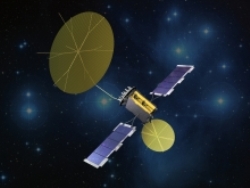Lockheed Martin recently demonstrated that the U.S. Navy’s Mobile User Objective System (MUOS) satellites may help solve communication challenges in the arctic. Now people spread over thousands of square miles could have access to more secure, reliable communications. During company-funded tests, MUOS voice and data signals reached much farther north than previously thought, just 30 miles and 0.5 degrees of latitude shy of the North Pole.
 Demonstrations show MUOS satellite signal can reach far into the arctic, beyond its required reach. That’s an important advantage in the far north, which has seen an increase in shipping, resource exploration and tourism without much improvement in secure satellite communications access.
Demonstrations show MUOS satellite signal can reach far into the arctic, beyond its required reach. That’s an important advantage in the far north, which has seen an increase in shipping, resource exploration and tourism without much improvement in secure satellite communications access.
A team demonstrated Wideband Code Division Multiple Access (WCDMA) capability using three different radios as far north as 89.5 degrees, under peak orbit conditions. This inherent voice and data access is well beyond the 65-degree system requirement.
The additional coverage comes at a time when demand is surging for dependable polar communications.
“As the arctic becomes more accessible, the U.S. and its allies need reliable communications to maintain a safe and secure presence,” said Paul Scearce, director of Military Space Advanced Programs at Lockheed Martin. “Demand for consistent voice and data services will only increase. The area is experiencing more shipping, tourism and natural resource exploration, which will also likely increase demands for search and rescue.”
The demonstrations show MUOS has an advantage over legacy satellite communications.
“This joint testing gave us important system operation data at extreme conditions,” said Dr. Amy Sun, Narrowband Advanced Programs lead at Lockheed Martin. “We did these evaluations to explore growing arctic communication demand, yet it also highlighted the dramatic capability improvements the WCDMA architecture will provide. Using MUOS, we were able communicate from the aircraft at high latitudes, which wasn’t the case for the legacy Ultra High Frequency signal.”
Lockheed Martin performed two rounds of testing late last year aboard an L-100 aircraft, the commercial variant of the C-130 Hercules. Multi-hour flights set out from Barrow, Alaska to test transmit and receive capabilities. Three terminal providers developing MUOS-compatible radios were on board, including the General Dynamics PRC-155 Manpack, the Harris PRC-117G Manpack and the Rockwell Collins ARC-210 V5 airborne terminal.
Anticipated shipping lanes will see full coverage 24 hours a day, with signal gradually dropping off farther north to 89.5 degrees, which can be achieved at peak orbit conditions. Airborne terminals can connect further north than sea level terminals, but at reduced durations.
The Antarctic should see similar performance results. Lockheed Martin plans on evaluating MUOS signal strength there, as well.
Lockheed Martin Space Systems, Sunnyvale, Calif., is the MUOS prime contractor and system integrator. The Navy's Program Executive Office for Space Systems and its Communications Satellite Program Office, San Diego, Calif., are responsible for the MUOS program.
Headquartered in Bethesda, Md., Lockheed Martin is a global security and aerospace company that employs approximately 115,000 people worldwide and is principally engaged in the research, design, development, manufacture, integration and sustainment of advanced technology systems, products and services. The Corporation’s net sales for 2013 were $45.4 billion.